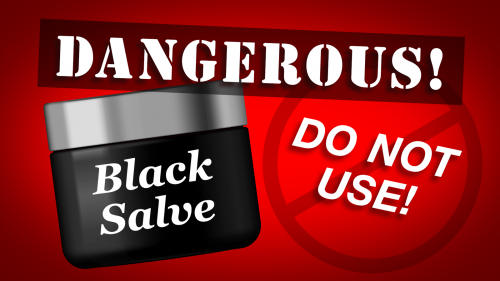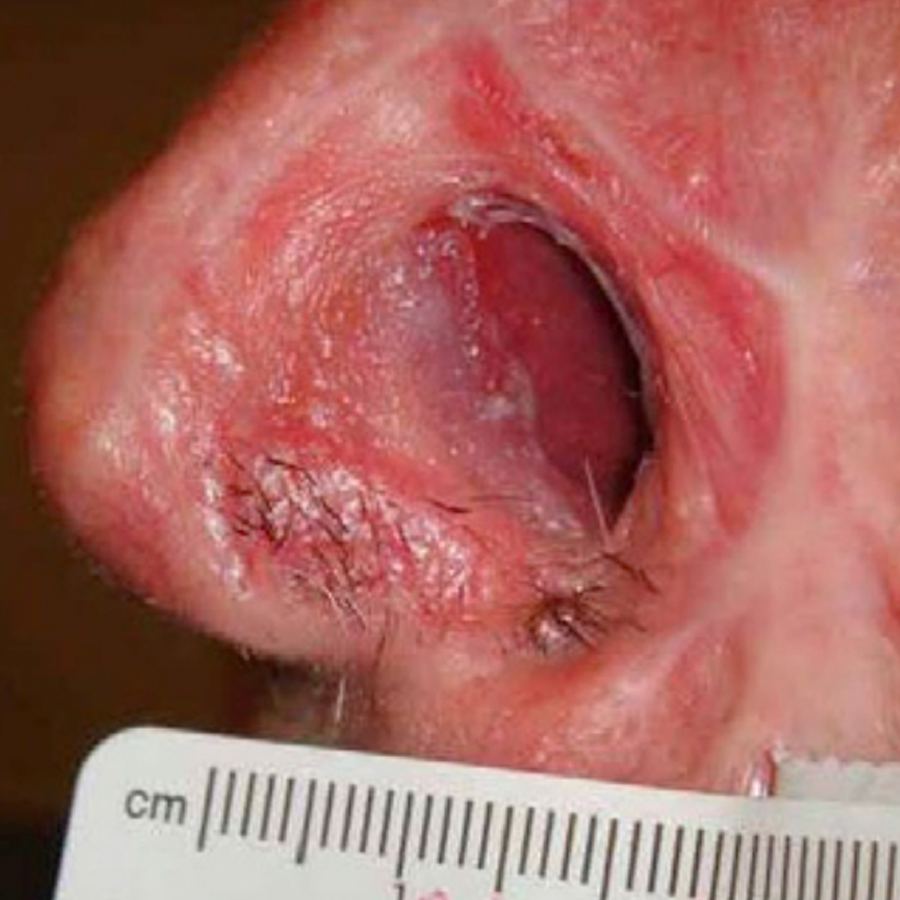How Does Prid Drawing Salve Work
Do Non Use: Black Relieve is Dangerous and Called past Many Names
Salves that contain corrosive ingredients, including "black salve" and a number of other names, are dangerous and can be life-threatening.
Image

Español
Yous may have seen websites selling sure salves or creams (commonly known as "black relieve") claiming to treat or cure cancer, boils, moles and peel tags (benign, or non-cancerous, growths of the skin).
These claims are simulated. Relieve products containing corrosive ingredients, including black relieve, are dangerous and are not approved by the U.Southward. Nutrient and Drug Administration (FDA) to treat or cure any skin condition, especially not peel cancer. Specifically, the FDA is alarm consumers non to use whatever salves or other topically applied products that listing any of the following potentially dangerous ingredients: sanguinarine, Sanguinaria canadensis, or bloodroot, alone or in combination with zinc chloride.
Although not all salves are dangerous, topically applied products with the in a higher place ingredients can destroy the skin and result in permanent disfigurement, tissue necrosis (expiry of cells in living tissue), and can result in infection. Furthermore, using salvage products such every bit black salve for serious conditions like skin cancer can upshot in delayed cancer diagnosis and cancer progression.
Report Adverse Events
What Are Salves that Contain Corrosive Ingredients?
Some salve products contain corrosive ingredients, highly reactive substances that hurt living tissue. They human action either straight, by chemically destroying the tissue (oxidation), or indirectly past causing inflammation. Either manner, the outcome is damaging, painful and tin can event in permanent disfigurement (scarring).
Many salvage products that contain corrosive ingredients claim to describe out only the cancer, leaving healthy skin untouched. This is false. The ingredients in these products destroy cancerous and healthy pare equally. Using these products tin result in permanent scarring and may fifty-fifty effect in the demand for reconstructive (plastic) surgery. In addition, these salves tin destroy the top layer of skin while leaving cancer behind in the deeper layers, where the cancer may continue to abound.
How Do Yous Know If It's A Corrosive Salve?
Corrosive salve products include products such as blackness salve. According to Cynthia Ng in the FDA's Center for Drug Evaluation and Inquiry, "Consumers need to know that 'blackness save' is an informal term and not the just name used for this product."
It is also sold under such names as Skinprov, drawing save, scarlet relieve, Cansema, bloodroot, Indian Herb, Hawk Dok Natural Salve, Black Drawing Ointment, and many others. The products come up in many forms including salve, paste, cream and poultice (soft, moist material applied to wound). In some cases, corrosive salves may exist marketed as natural or homeopathic products. In some instances, the corrosive ingredients are listed as "inactive" ingredients.
Ng adds that if you're not sure if a production is, in fact, a unsafe blackness save product, y'all can look for these (active and/or inactive) ingredients: sanguinarine, Sanguinaria canadensis, bloodroot, and zinc chloride, whatsoever of which signal that it is a harmful product and you should non use it.
Watch out for the post-obit red flags:
- Relieve products with the following names: black salve, drawing salve, crimson salve, Cansema, bloodroot, Indian Herb, Hawk Dok Natural Salvage, Blackness Drawing Ointment, and many others. The products come up in many forms including salves, pastes, creams, and poultices.
- Products that comprise any of these ingredients: sanguinarine, Sanguinaria canadensis, bloodroot, and zinc chloride.
- Salve products that claim to cure or treat cancer, remove moles or warts, or treat other peel weather condition.
- Products with instructions to expect burning, pain, or scar formation at the application site. The sellers ofttimes state to expect a thick, dry scab on the skin.
Consumers Have Reported Harmful Side Effects to the FDA
The FDA has identified 24 cases of adverse events (bad side effects) associated with black relieve. Fifteen of these cases were reported within the by 5 years.
These have included instances of permanent disfigurement and cancer progression. The FDA is aware of at least one death that resulted from a person who opted to apply a corrosive relieve rather than pursue proven cancer therapies.
The bureau urges consumers to see a health care professional to obtain an accurate diagnosis and receive appropriate treatments.
The agency as well continues to transport warning letters and take enforcement action against companies making simulated claims about these products.
To report agin events or side effects related to the use of these products, health care professionals and consumers can:
- Complete and submit an online written report at MedWatch Prophylactic Information and Adverse Event Reporting Plan, or
- Telephone call 1-800-332-1088 to asking a reporting form, then complete and render to the form to the address on the form, or by faxing it to ane-800-FDA-0178.
Other Things You Tin can Do to Stay Safe
- Contact your health intendance professional or dermatologist if you take whatever concerns about skin cancer or other skin-related problems. Be sure to tell them about any products, including herbal or other "natural" products, that you may be using for whatsoever skin-related issues.
- Exercise non use black save or relieve products that contain sanguinarine, Sanguinaria canadensis, or bloodroot, alone or in combination with zinc chloride, as an culling to proven medical therapies. This can upshot in permanent disfigurement and in the worst case, death.
- Learn how to recognize health fraud scams.
Source: https://www.fda.gov/consumers/consumer-updates/do-not-use-black-salve-dangerous-and-called-many-names
Posted by: aquinowassent.blogspot.com



0 Response to "How Does Prid Drawing Salve Work"
Post a Comment